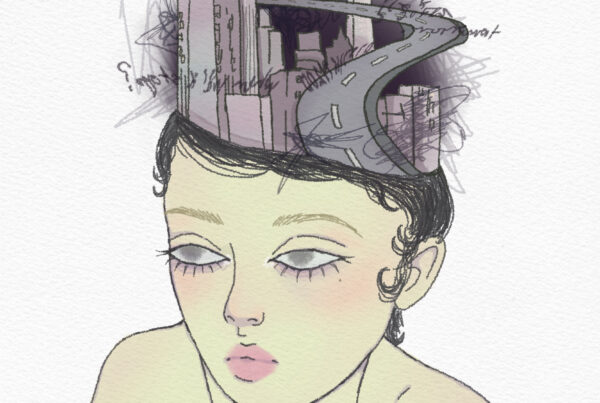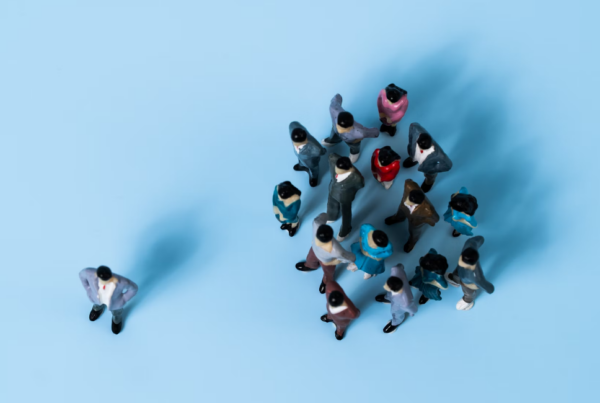
Loneliness is a painful experience that can take many different forms. This article explores how being busy can be misleading, why the elderly are not the loneliest group, and how serious the consequences of loneliness are – for individuals, but also for society.
Loneliness is a painful experience that can take many different forms. This article explores how being busy can be misleading, why the elderly are not the loneliest group, and how serious the consequences of loneliness are – for individuals, but also for society.

Illustration by Nina Kollof

Illustration by Nina Kollof
People are busy, and modern life almost needs us to be. We get up early, because we like to feel productive and hand in our things on time. We bounce from meeting to meeting to a late take-away dinner, because we don’t have time to cook again. And we spend hours on public transport, staring at our phones, or binge-watching our favourite show. Sometimes we even make it to the gym, and we are proud of that. And while we seem to function so terribly well in society, there are things in life that need to be less scheduled, more organic, more human: Our social life. And by that, I mean a social life that goes beyond the chit-chat with your barista in the morning or your lunch with colleagues. People can be busy, even incredibly social, and yet lonely. Loneliness is not reserved for the elderly, sitting in a chair by the window as the world runs by. It is also for the people running by, feeling disconnected from the rest.
Loneliness is often invisible, and this is what makes it so tricky. Per definition, it describes a deficit: If you have fewer social connections and interactions than you would want to have, you might feel lonely. This highlights how subjective loneliness is, how it cannot be measured by the size of your social networks or the number of times you meet friends for dinner. But when asking people around the world, the answer is still clear: Many of us feel lonely, and many do so all the time. London for example seems to be one of the lonelier places on this planet, as confirmed by 55% of citizens in a survey (Parsons, 2017) – especially if they have lived there for five years or less. Similar numbers can be found in cities like New York, where 57% agreed with the statement that they feel lonely some or most of the time (Leland, 2022). This loneliness epidemic, as the New York Times coined it, has received so much attention that famous sex counsellor Dr. Ruth Westheimer is now the Big Apple’s first loneliness ambassador (Gilbert, 2023).
However, the loneliness epidemic is not only affecting people in big cities like London or New York as it might seem looking at these statistics. Given that we have all lived through a pandemic, the topic of loneliness has further increased in relevance also outside of the urban realm. Government-prescribed physical distancing certainly did not improve our social situation, but the consequences of loneliness have worried behavioural and medical scientists for much longer. Lonely people have a significantly higher risk of mental disorders such as anxiety, depression, eating disorders, and substance abuse. Loneliness also has a serious impact on physical health: It is linked to a weaker immune system, high blood pressure, heart disease, and premature death (Hartman, 2023; Leland, 2022; WHO, n.d.). It is quite literally fatal if we ignore this problem.
“Loneliness is not reserved for the elderly, sitting in a chair by the window as the world runs by. It is also for the people running by, feeling disconnected from the rest.”
Investigating who is at risk for loneliness and its concerning consequences, a recent study with data from roughly 45,000 participants around the world has shown: Young people report loneliness the most (Barreto et al., 2021). This might be surprising at first since the most frequently encountered narrative around loneliness concerns the elderly. But upon closer inspection, it becomes evident that many factors contributing to loneliness are very present in many young people’s lives.
First, students and young professionals move around frequently and often live in bigger cities, making it quite difficult to establish strong friendships and relationships in such a volatile environment (Molzner, n.d.). More than that, the city life itself seems to have a negative impact on loneliness and mental health. Long commutes, high-rise buildings, unaffordable housing, and anti-social urban design all cater towards an isolated lifestyle (Fu, 2020). Even the important, community-fostering “third places” such as youth centres, libraries, gyms, or cafés are often hard to access if you are new in a city and don’t know anyone there, or if you live far away from the city centre.
Second, factors relating to a person’s identity can make it even harder to connect to others. For example, having a chronic illness or disability, or belonging to a racial minority or the LGBTQ+ community can contribute to the individual experience of loneliness (Fu, 2020). Young people are very much in the process of forming and strengthening their identity, which places an even bigger emphasis on these aspects.
Third, the young generation is the first to grow up with technology being so ubiquitous. While online interactions and media consumption might simulate a busy social life, it does not quite fulfil the need for belonging and love like real-world interactions do. Research from the pandemic has shown that engagement with the online world, especially in a passive way such as mindless scrolling or watching videos, is associated negatively with our well-being (Sun et al., 2022).
“Long commutes, high-rise buildings, unaffordable housing, and anti-social urban design all cater towards an isolated lifestyle (Fu, 2020).”
Being aware of these factors is a small but crucial first step to start reconnecting. Dr. Ruth said to the New York Times that “the first thing to do is have the courage to admit you’re lonely” – but this is so hard. Please, look around you and do not expect only old people to be lonely. Check in with the busy bees and workaholics in your life, reach out to the quiet ones in your student housing, and go the extra mile for the friends and colleagues who would do the same for you. Because the worst thing we could do when tackling loneliness is point the finger at the ones suffering. “Just put yourself out there and make some friends” will not solve this issue.
Remembering that loneliness can affect people of all ages, genders, and backgrounds emphasises that we have to think in more structural ways to successfully reconnect with each other (Murthy, 2023). For example, adopting a more conscious way of designing urban spaces and third places for people to meet and connect could be a great start (Harris, 2019). Supporting teachers not only in their educational role, but also when they facilitate social connections between pupils. Creating meaningful and engaging ways of online socialising that go beyond mindless consumption. Helping people to disconnect from work and reconnect with their community, making them feel wanted and needed outside of the responsibilities that life throws our way. There are endless ways in which we can tackle this issue, not only through policies and social interventions, but starting with our own behaviour in everyday life. In all this running around, let us not forget about one of our most basic needs: connection. <<
References
– Barreto, M., Victor, C., Hammond, C., Eccles, A., Richins, M. T., & Qualter, P. (2021). Loneliness around the world: Age, gender, and cultural differences in loneliness. Personality and Individual Differences, 169, 110066. https://doi.org/10.1016/j.paid.2020.110066
– Fu, K. (2020). Strangers in the sky: A designer’s guide to tackling urban loneliness, part A. Medium. https://medium.com/humanics/strangers-in-the-sky-a-designers-guide-to-tackling-urban-loneliness-part-a-31991bd66e60
– Gilbert, A. (2023). Dr. Ruth saved people’s sex lives. Now she wants to cure loneliness. The New York Times. https://www.nytimes.com/2023/11/09/nyregion/dr-ruth-loneliness-ambassador.html
– Harris, E. (2019). Social isolation and its relationship to the urban environment. Social Connectedness. https://www.socialconnectedness.org/wp-content/uploads/2019/12/Emma-Harries-Social-Isolation-and-its-Relationship-to-the-Urban-Environment.pdf
– Hartman, C. (2023). Loneliness statistics. Roots of loneliness. https://www.rootsofloneliness.com/loneliness-statistics#Loneliness_And_Age
– Leland, J. (2022). How loneliness is damaging out health. The New York Times. https://www.nytimes.com/2022/04/20/nyregion/loneliness-epidemic.html
– Molzner, C. (n.d.). Urban loneliness and isolation: The dark side of living in a big city. Roots of Loneliness. https://www.rootsofloneliness.com/urban-loneliness-isolation
– Murthy, V.H. (2023). Surgeon General: We have become a lonely nation. It’s time to fix that. The New York Times. https://www.nytimes.com/2023/04/30/opinion/loneliness-epidemic-america.html
– Parsons, G. (2017). London is among the loneliest cities in the world. Time Out. https://www.timeout.com/london/blog/london-is-among-the-loneliest-cities-in-the-world-021617
– Sun, R., Rieble, C., Liu, Y., & Sauter, D. (2022). Connected despite lockdown: the role of social interactions and social media use in wellbeing. Collabra: Psychology, 8(1), 37061. https://doi.org/10.1525/collabra.37061
– World Health Organisation [WHO] (n.d.). Social Isolation and loneliness. https://www.who.int/teams/social-determinants-of-health/demographic-change-and-healthy-ageing/social-isolation-and-loneliness
People are busy, and modern life almost needs us to be. We get up early, because we like to feel productive and hand in our things on time. We bounce from meeting to meeting to a late take-away dinner, because we don’t have time to cook again. And we spend hours on public transport, staring at our phones, or binge-watching our favourite show. Sometimes we even make it to the gym, and we are proud of that. And while we seem to function so terribly well in society, there are things in life that need to be less scheduled, more organic, more human: Our social life. And by that, I mean a social life that goes beyond the chit-chat with your barista in the morning or your lunch with colleagues. People can be busy, even incredibly social, and yet lonely. Loneliness is not reserved for the elderly, sitting in a chair by the window as the world runs by. It is also for the people running by, feeling disconnected from the rest.
Loneliness is often invisible, and this is what makes it so tricky. Per definition, it describes a deficit: If you have fewer social connections and interactions than you would want to have, you might feel lonely. This highlights how subjective loneliness is, how it cannot be measured by the size of your social networks or the number of times you meet friends for dinner. But when asking people around the world, the answer is still clear: Many of us feel lonely, and many do so all the time. London for example seems to be one of the lonelier places on this planet, as confirmed by 55% of citizens in a survey (Parsons, 2017) – especially if they have lived there for five years or less. Similar numbers can be found in cities like New York, where 57% agreed with the statement that they feel lonely some or most of the time (Leland, 2022). This loneliness epidemic, as the New York Times coined it, has received so much attention that famous sex counsellor Dr. Ruth Westheimer is now the Big Apple’s first loneliness ambassador (Gilbert, 2023).
However, the loneliness epidemic is not only affecting people in big cities like London or New York as it might seem looking at these statistics. Given that we have all lived through a pandemic, the topic of loneliness has further increased in relevance also outside of the urban realm. Government-prescribed physical distancing certainly did not improve our social situation, but the consequences of loneliness have worried behavioural and medical scientists for much longer. Lonely people have a significantly higher risk of mental disorders such as anxiety, depression, eating disorders, and substance abuse. Loneliness also has a serious impact on physical health: It is linked to a weaker immune system, high blood pressure, heart disease, and premature death (Hartman, 2023; Leland, 2022; WHO, n.d.). It is quite literally fatal if we ignore this problem.
“Loneliness is not reserved for the elderly, sitting in a chair by the window as the world runs by. It is also for the people running by, feeling disconnected from the rest.”
Investigating who is at risk for loneliness and its concerning consequences, a recent study with data from roughly 45,000 participants around the world has shown: Young people report loneliness the most (Barreto et al., 2021). This might be surprising at first since the most frequently encountered narrative around loneliness concerns the elderly. But upon closer inspection, it becomes evident that many factors contributing to loneliness are very present in many young people’s lives.
First, students and young professionals move around frequently and often live in bigger cities, making it quite difficult to establish strong friendships and relationships in such a volatile environment (Molzner, n.d.). More than that, the city life itself seems to have a negative impact on loneliness and mental health. Long commutes, high-rise buildings, unaffordable housing, and anti-social urban design all cater towards an isolated lifestyle (Fu, 2020). Even the important, community-fostering “third places” such as youth centres, libraries, gyms, or cafés are often hard to access if you are new in a city and don’t know anyone there, or if you live far away from the city centre.
Second, factors relating to a person’s identity can make it even harder to connect to others. For example, having a chronic illness or disability, or belonging to a racial minority or the LGBTQ+ community can contribute to the individual experience of loneliness (Fu, 2020). Young people are very much in the process of forming and strengthening their identity, which places an even bigger emphasis on these aspects.
Third, the young generation is the first to grow up with technology being so ubiquitous. While online interactions and media consumption might simulate a busy social life, it does not quite fulfil the need for belonging and love like real-world interactions do. Research from the pandemic has shown that engagement with the online world, especially in a passive way such as mindless scrolling or watching videos, is associated negatively with our well-being (Sun et al., 2022).
“Long commutes, high-rise buildings, unaffordable housing, and anti-social urban design all cater towards an isolated lifestyle (Fu, 2020).”
Being aware of these factors is a small but crucial first step to start reconnecting. Dr. Ruth said to the New York Times that “the first thing to do is have the courage to admit you’re lonely” – but this is so hard. Please, look around you and do not expect only old people to be lonely. Check in with the busy bees and workaholics in your life, reach out to the quiet ones in your student housing, and go the extra mile for the friends and colleagues who would do the same for you. Because the worst thing we could do when tackling loneliness is point the finger at the ones suffering. “Just put yourself out there and make some friends” will not solve this issue.
Remembering that loneliness can affect people of all ages, genders, and backgrounds emphasises that we have to think in more structural ways to successfully reconnect with each other (Murthy, 2023). For example, adopting a more conscious way of designing urban spaces and third places for people to meet and connect could be a great start (Harris, 2019). Supporting teachers not only in their educational role, but also when they facilitate social connections between pupils. Creating meaningful and engaging ways of online socialising that go beyond mindless consumption. Helping people to disconnect from work and reconnect with their community, making them feel wanted and needed outside of the responsibilities that life throws our way. There are endless ways in which we can tackle this issue, not only through policies and social interventions, but starting with our own behaviour in everyday life. In all this running around, let us not forget about one of our most basic needs: connection. <<



